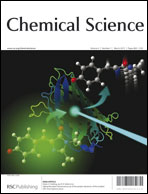Pinning down the solid-state polymorphism of the ionic liquid [bmim][PF6]†
Abstract
The solid-state polymorphism of the ionic liquid 1-butyl-3-methylimidazolium hexafluorophosphate, [bmim][PF6], has been investigated via low-temperature and high-pressure crystallisation experiments. The samples have been characterised by single-crystal X-ray diffraction, optical microscopy and Raman spectroscopy. The solid-state phase behaviour of the compound is confirmed and clarified with respect to previous phase diagrams. The structures of the previously reported γ-form, which essentially exhibits a G′T cation conformation, as well as those of the elusive β- and α-forms, are reported. Crystals of the β-phase are twinned and the structure is heavily disordered; the cation conformation in this form is predominantly TT, though significant contributions from other less frequently encountered conformers are also observed at low temperature and high pressure. The cation conformation in the α-form is GT; the presence of the G′T conformer at 193 K in this phase can be eliminated on cooling to 100 K. Whilst X-ray structural data are overall in good agreement with previous interpretations based on Raman and NMR studies, they also reveal a more subtle interplay of intermolecular interactions, which give rise to a wider range of conformers than previously considered.
![Graphical abstract: Pinning down the solid-state polymorphism of the ionic liquid [bmim][PF6]](/en/Image/Get?imageInfo.ImageType=GA&imageInfo.ImageIdentifier.ManuscriptID=C2SC21959J&imageInfo.ImageIdentifier.Year=2013)

 Please wait while we load your content...
Please wait while we load your content...